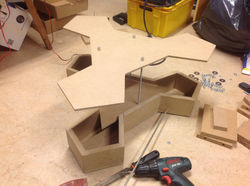
GELUIDKUNSTENAAR
Fedde ten Berge
Water Line (Verschanste Klanken)
(2015) Water Line is an interactive audio installation inspired on the former dutch water defense line. It uses sounds from the fortress as well as sound synthesis inspired by sounds of the fortress. The public can relate to these sounds in a musical way by touching the object. The installation was embedded in the Fortress of Maarssenveen near Utrecht (The Netherlands) during my solo exhibition Verschanste Klanken. The ‘Metaalkathedraal’ in Utrecht invited me to exhibit this installation during minister Bussemaker’s national presentation about her new policy and devision of money in the cultural sector. Minister Bussemaker reacted very surpised and enthousiastic to my piece. The ‘NOS-journaal’ (national television) registrated our encounter on the 8th of June 2015 and made an item out of it for the daily national news (het NOS acht uur journaal).
 |  |  |
|---|---|---|
 |  |  |
 |  |  |
 |  |  |
 |  |  |
 |  |  |
 |  |  |
 |  |  |
 |  |  |
 |  |  |
The geometrical shapes and natural surrounding of the fortress were the starting point for the design of the installation. The public can interact with the object using an Arduino based multiple implementation of the Touché principle. Each ceramic bowl has electrodes attached to it. Subsequently two types of algorithmic principles form the base for two types of musical instruments that are coupled to each ceramic bowl. Each ceramic bowl has it’s own design of musical instrument. So in total there are 6 types of algorithmic electronic musical instruments designed into the system.
Bowl 1: The movement of the hand above the bowl is used to trigger a convolution algorithm in which the sound of Human Breath is convolved with the squeaking of a metal fortress door. When the water in the bowl is touched this sound design gets a random amplitude modulation applied to it on a randomly chosen speaker.
Bowl 2: The movement of the hand above the bowl is used to fill frequency depended gain tables. These gain tables are operated on background noise of the fortress using Fourier re-synthesis. By touching the water samples from the squeaking of the wooden floors are triggered and transformed into multiple modulation delays. Each time the water is touched a new loudspeaker pair is set to project the sound of the modulation delays.
Bowl 3: The movement of the hand above the bowl is used to enhance the resonant frequencies within the humming sound coming from the fluorescent tubes that are hanging in the fortress.The water surface can be played with the finger tips. The touches are mapped into a atonal note system with custom designed reverb. For the sound projection a 2 channel sound card and 3 loudspeakers are used. Both of the audio channels coming from the sound card can be routed to each of the 3 loudspeakers by the use of two Arduino controlled multiplexers. The multiplexers are controlled from Pure Data via OSC. All of the audio instruments were designed in pure data and the scripts where coded in phyton and the arduino wire script language. The system runs on a dual core Banana Pi and is optimized for realtime audio generation. The system is autonomous, has a save shutdown procedure and is externally programmable via the internet.
Concept, building and composition: Fedde ten Berge.
Ceramics: Frank van Os (Barst!)
Loudspeakerstands: Jesse Meijer